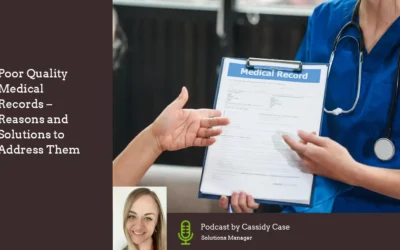Podcast Highlights
00:22 – What Is HEDIS?
00:53 – How HEDIS Data is Collected
1:30 – What Types of Data are Used for HEDIS Reporting?
1:58 – Why HEDIS Scores Matter for Healthcare Providers
2:22 – How to Improve HEDIS Scores Through Medical Record Review
2:54 – HIPAA and Medical Record Sharing for HEDIS
3:10 – What’s New in HEDIS for 2023
3:47 – Final Thoughts
HEDIS Measures and the Medical Record Review Process
Read Transcript
00:22 – What Is HEDIS?
Now, if you’re involved in healthcare – whether as a provider, administrator, or data analyst – you’ve likely heard of HEDIS and therefore, I’m not going to elaborate on it much. Healthcare Effectiveness Data and Information Set is a standardized set of performance measures developed by the National Committee for Quality Assurance, or NCQA. More than 90% of health plans across the U.S. rely on HEDIS to evaluate provider performance, meet regulatory mandates, and eventually, improve patient outcomes.
00:53 – How HEDIS Data is Collected
So, how is this data collected? Well, HEDIS data comes from a few key sources like surveys, insurance claims, and yes, medical chart reviews. These reviews are conducted using data from hospitals, labs, pharmacies, and physician offices. NCQA-approved auditing firms play a vital role in assessing this documentation, after which the results are published publicly. Consumers can then use these scores to compare health plans and local providers, which means these reviews directly impact a provider’s reputation and even financial incentives.
1:30 – What Types of Data are Used for HEDIS Reporting?
Now, let’s talk a little more about the medical record review process, because this is where things get really interesting. The process includes three major types of reviews:
- First, is the administrative review, which looks at claims data
- Second is the patient surveys, which capture patient experiences, and
- Third, hybrid reviews, which combine both administrative data and information pulled directly from patient medical records.
1:58 – Why HEDIS Scores Matter for Healthcare Providers
These reviews are what helps identify any inconsistencies in care, monitor preventive service delivery, and support the assessment of improvement initiatives. For providers, higher HEDIS scores can mean an increased revenue through Pay for Performance or Value-Based Care models. However, that all depends on the quality of the documentation and data accuracy.
2:22 – How to Improve HEDIS Scores Through Medical Record Review
So, how do providers improve their HEDIS scores? Through a diligent medical record review process.
It all starts with delivering prompt, appropriate care – and just as importantly – documenting and coding it accurately. Providers must also respond to record requests in a timely manner, preferably within 5 to 7 business days, and make sure that all relevant services are captured, even those that generally do not show up in claims data.
2:54 – HIPAA and Medical Record Sharing for HEDIS
It’s also worth noting that HIPAA allows this type of data sharing without requiring patient authorization, as long as it’s for quality assessment and improvement purposes. So rest assured, this process is fully compliant.
3:10 – What’s New in HEDIS for 2023
Now, each year, NCQA updates the HEDIS measures to reflect current healthcare priorities. For 2023, some key additions include pediatric dental care evaluations, benzodiazepine deprescribing in older adults, emergency visits for hypoglycemia in diabetics, and screening for social needs like food and housing.
And yes – some measures have been retired or revised. For example, the Annual Dental Visit measure has been replaced by more targeted evaluations like Oral Evaluation Dental Services and Topical Fluoride for Children.
3:47 – Final Thoughts
At the end of the day, HEDIS is more than just a measurement system. It’s a powerful tool for driving positive changes in population health, reducing care costs, and aligning provider performance with national healthcare expectations.
As a company that specializes in AI medical record review, we’re committed to helping healthcare organizations deliver clear, compliant, and complete data that improves HEDIS scores – and more importantly, improves patient outcomes.
Thanks for tuning in today. I’m Julie Clements, and we’ll catch you next time on our podcast series. Until then, keep striving for better care, better data, and better health.
Disclaimer: This podcast features human-written content, narrated using AI-generated voice. This is intended for informational purposes.



